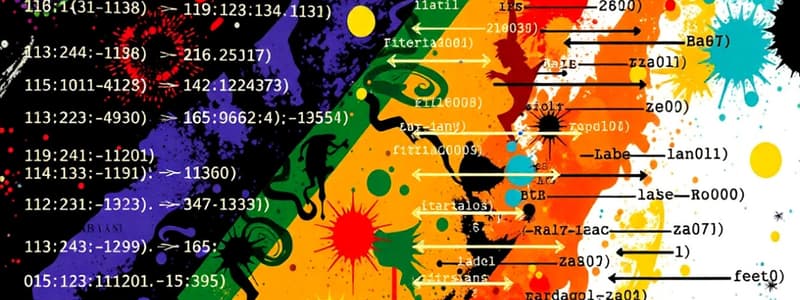Podcast
Questions and Answers
Which of the following describes a linear data structure?
Which of the following describes a linear data structure?
- Elements are stored in a hierarchical format.
- Elements are connected like a tree.
- Elements can be accessed in multiple ways.
- Elements are arranged in a sequential manner. (correct)
What distinguishes nonlinear data structures from linear data structures?
What distinguishes nonlinear data structures from linear data structures?
- Nonlinear data structures do not have relationships among elements.
- Nonlinear data structures are more straightforward in terms of implementation.
- Nonlinear data structures allow for multiple paths to access data. (correct)
- Nonlinear data structures can be traversed in one direction only.
Which application area would typically use a tree data structure?
Which application area would typically use a tree data structure?
- Implementing a backtracking algorithm.
- Representing hierarchical relationships like file systems. (correct)
- Maintaining a priority queue.
- Storing data in a linear array.
Which scenario is most suitable for utilizing a graph data structure?
Which scenario is most suitable for utilizing a graph data structure?
Which of the following is NOT a characteristic of linear data structures?
Which of the following is NOT a characteristic of linear data structures?
Flashcards
Application Areas of Data Structures
Application Areas of Data Structures
Different fields where data structures are utilized, such as databases, graphics, and operating systems.
Linear Data Structures
Linear Data Structures
Data structures where elements are arranged in a sequential manner, like arrays and linked lists.
Nonlinear Data Structures
Nonlinear Data Structures
Data structures where elements are not arranged sequentially, such as trees and graphs.
Arrays
Arrays
Signup and view all the flashcards
Linked Lists
Linked Lists
Signup and view all the flashcards
Study Notes
Application Areas of Data Structures
- Data structures are fundamental building blocks in computer science, enabling efficient organization and manipulation of data. Their choice significantly impacts algorithm performance in various applications.
- Arrays: Efficient for storing and accessing elements by index. Commonly used in numerical computation, simulation, and image processing. They are particularly suitable for situations requiring fast random access, but resizing can be slow and inefficient.
- Linked Lists: Suitable for dynamic data that needs frequent insertion or deletion. They are useful for implementing stacks, queues, and other abstract data types. Memory allocation is flexible, but accessing elements by index requires traversing the list, which can be slower than arrays for random access.
- Stacks: Used in expression evaluation, function call management, and undo/redo mechanisms. Their last-in, first-out (LIFO) nature makes them ideal for managing temporary data or handling recursive algorithms.
- Queues: Implement first-in, first-out (FIFO) data management. Essential in tasks like scheduling processes, buffering data streams, or managing requests in printers or web servers.
- Trees: Represent hierarchical relationships. Widely used in file systems, decision-making processes, and representing organizational structures. They excel at navigating related data efficiently and handling hierarchical relationships.
- Graphs: Model pairwise relationships between data. Crucial in social networking analysis, route planning, recommendation systems, and network simulations. Their flexibility enables modelling complex relationships.
- Hash Tables: Provide fast lookups based on key values. Critical in database systems, caching mechanisms, and symbol tables. Their speed depends on the hash function's quality.
- Priority Queues: Maintain elements with associated priorities, enabling efficient retrieval of the highest-priority element. Used in scheduling algorithms, event simulation, and tasks needing prioritization.
Linear Data Structures
-
Linear data structures arrange data elements sequentially, one after another. Each element has a direct predecessor and successor except for the first and last elements.
-
Characteristics:
- Simple implementation.
- Sequential access to elements.
- Elements are stored in a contiguous or linked manner.
-
Examples: Arrays, Linked Lists, Stacks, Queues.
-
Applications: Array structures are excellent for numerical computations. Queues are ideal for tasks needing first-in-first-out order, and stacks serve tasks requiring last-in-first-out operations, such as expression evaluation. Linked lists facilitate efficient insertion and deletion.
Non-Linear Data Structures
- Non-linear data structures do not follow a linear sequence. Data elements are not arranged sequentially. Relationships between elements can be complex and multi-layered.
- Characteristics:
- Complex implementation compared to linear structures.
- Non-sequential access to elements.
- Relationships between elements can be complex and hierarchical.
- Examples: Trees, Graphs.
- Applications: Trees excel in representing hierarchical data, such as a file system. Graphs are used in network simulations, social network analysis, and route finding algorithms. For example, determining optimal routes uses graph theory to find paths between nodes or vertices in the structure.
Studying That Suits You
Use AI to generate personalized quizzes and flashcards to suit your learning preferences.




